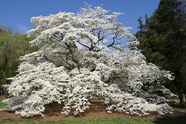 Historic Dogwood Tree, Huntsville Botanical Garden, Hunstville, AL 2009 (Photo courtesy Michael Hartley)
Historic Dogwood Tree, Huntsville Botanical Garden, Hunstville, AL 2009 (Photo courtesy Michael Hartley) The dogwood has fascinated me ever since and has become my favorite flower. When it blooms, and it only blooms for about two weeks in the beginning of April (always around Easter, coincidentally enough), I feel like a sixteen-year-old again, walking with my family and listening to my father both regale and educate us with the dogwood’s divine legend. That same spring, I began to do some research. I became somewhat of a dogwood aficionado. While studying and reading up on the dogwood, I stumbled upon the most beautiful photograph of the biggest dogwood tree that I had ever seen. I thought this tree is more than likely inaccessible to me; it’s just too good to be true. I would later come to find that the tree wasn’t always too good to be true; I was just too late.
The majestic dogwood tree was more than 120 years old and was located in Huntsville at the Huntsville Botanical Gardens. The dogwood was moved from an old homestead on Old Madison Pike to the Gardens on May 17, 1996, as a result of highway construction. It was 23 feet tall and 44 feet wide, weighing approximately 83,000 pounds. The community both physically and financially helped with the re-placement of the tree and, according to a plaque that remains at the Gardens, the tree “reflects the caring spirit” that resides within the community. The pictures of the stark white dogwood continued to entice me as I was doing my research. I became so excited that I began planning a road trip with my family up to north Alabama just to see this magnificent tree! Unfortunately, I would come to find that the tree had died and that it was no longer there at the Gardens. Old age and rot, they said. It had lived much longer than most. This stunning piece of natural history had disappeared; I was beyond disappointed.
Though the tree is no longer there at the Huntsville Botanical Gardens, its spirit lives on as around 30 percent of the tree was saved, allowing its admirers to plant new dogwoods in its memory. I’ve also come to find that Huntsville is a hot spot for dogwood trees and, according to the locals, they bloom and spread like wildfire in the spring! Garth Road in southeast Huntsville, Adams Street in Huntsville’s Historic District, and Maple Hill Cemetery, the oldest cemetery in Huntsville, are supposedly all fantastic places to see dogwood blooms. And though the Huntsville Botanical Gardens no longer has the mother of all dogwood trees, it still has a stunning dogwood trail – with sporadic natural dogwoods spanning for miles.
I often imagine what it would have been like to stand, dance, sing, and write under that tree. I try to look at it as truth to the legend. God did say that he would never make the dogwood tree big enough for its wood to be used in the making of a cross ever again. Though it lived a long, happy life, the Gardens’ dogwood had to live up to its legend. And it did, with beauty and grace. Though gone, it remains a large part of not only Huntsville’s history, but Alabama’s history. Not only a large part of Alabama’s history, but of my history. It is when I admirably examine a dogwood tree and its stunning blooms, just like my father did, that I’m reminded of family, of faith, of stories, and of home. I’m much like a dogwood in that way—just trying to live up to my legend.
 Taylor Zimmerman
Taylor ZimmermanColorado Springs, Colorado
 RSS Feed
RSS Feed